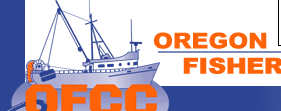| |
OFCC
receives Dept. of State Lands Partnership Award
The OFCC, an Astoria based non-profit that works with commercial
fishermen and subsea fiber-optic cables, received the Dept.
of State Lands 2018 Partnership Award from the State Land
Board Tuesday, June 11 in Salem. The Award is based on innovation,
consistency, effort and being a good example in partnership
with the Oregon Dept. of State Lands in stewardship of Oregon's
Natural Resources. The award recognized the over 20 year history
of the OFCC working cooperatively with submarine cable owners
and installers on projects to develop and land submarine cable
systems on the Oregon coast. These installations have been
done in a way that minimizes negative impacts to Oregon's
territorial sea and the Oregon fishing industry while providing
significant benefits to the State of Oregon. Oregon Secretary
of State Bev Clarno said, "This on-going collaboration has
resulted in responsible, sustainable stewardship of the territorial
sea and the natural resources it contains." She noted that
the increasing number of undersea cable landings in Oregon
resulted in a more robust internet backbone for our state,
development of data centers and cloud storage facilities and
better connectivity for tech companies. Sec. Clarno concluded
the presentation by noting that "Working together, the OFCC
and submarine cable owners have achieved what neither could
accomplish alone-making Oregon a very successful place to
land west coast fiber-optic cables while maintaining a vibrant
fishing industry. This "Oregon model" of cooperation among
stakeholders has been held up as an example globally.
The OFCC now has Google, Microsoft and Facebook as members
of our organization, along with older telecommunications companies
such as Verizon and TATA. Perhaps our biggest success has
been our 20 year record of not one cable fault on an OFCC
cable in the Oregon fishing grounds-even though we have about
1200 km of cable in the trawl grounds and an active fishing
fleet.
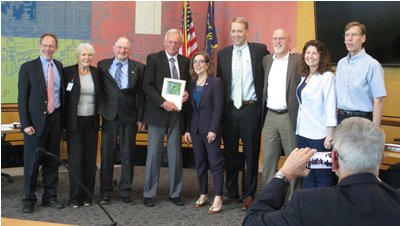
Rob Munier, OFCC Technical Advisor from Woods
Hole Oceanographic Institution, MA; Sec. of State Bev Clarno;
OFCC chair and former fisherman Scott McMullen; Terry Thompson,
Newport; Gov. Kate Brown; State Treasurer Tobias Read; Brad
Pettinger, Brookings; Joanne Morris, Google; Mikal Modisette,
Verizon
Successful Science Platform and Gear Recovery
Below are some additional pictures from the recent gear recovery that occurred. For more information and pictures, please visit our Facebook page. 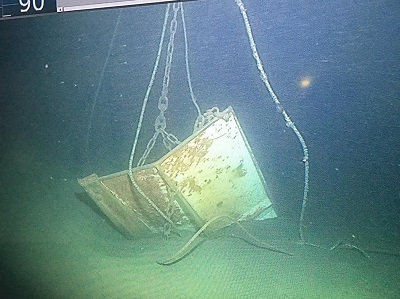
Starboard Trawl Door – ROV underwater video image
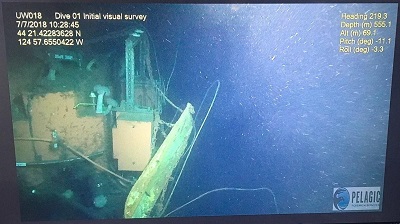
Underwater video image of Port Trawl Door and Sub-Surface Platform
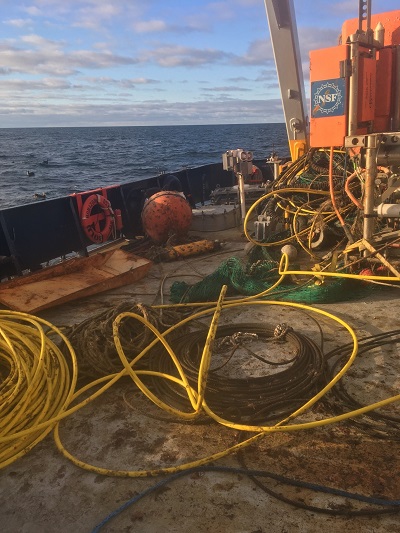
Recovered Gear and Science Platform
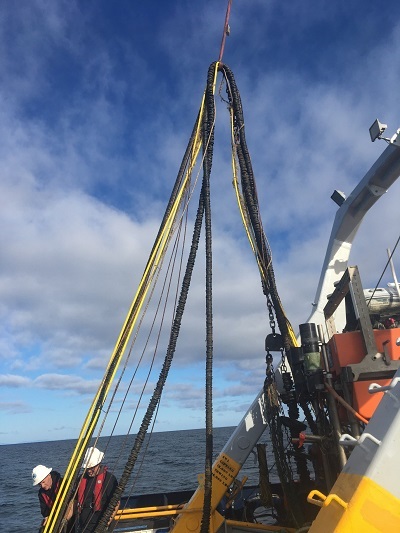
Bringing “bites” of mud gear and bridles aboard
Updated Cable
Route Files Available for Your Plotter
The OFCC recently updated OFCC cable route data layers for
marine navigation software programs used by the west coast
trawl fishing fleet. OFCC Cable Route Version 11 is available
on USB Flash Drives for TimeZero, Maptech Offshore Navigator©,
Coastal Explorer©, P-Sea WindPlot II©, ECC- Globe©,
Nobeltec©, Simrad-Olex©, and BndryWP. The updates
include the new Jupiter cable route just north of Pacific
City. These files are available on USB Flash Drives or by
e-mail free of charge to US West Coast Trawlers. Contact the
OFCC office at (503) 325-2285 or staff@ofcc.com
to receive a copy.
FASTER Cable Completed
The OFCC and Google began working on a route for the FASTER cable in July 2014. As part of this process, Google and OFCC reps worked with fishermen on their trawlers in Charleston to design the route to maximize burial in the fishing grounds by using the local knowledge of the trawl fleet. This was highly effective, as the route resulted in good burial through the trawl fishing grounds out to over 800 fms. Google continues to work closely with and has good relations with the OFCC.  With construction and end-to-end testing complete, a new trans-Pacific submarine cable system, the “FASTER Cable System,” started service on June 30, 2016. Construction of the system was announced in August 2014. The 9,000km trans-Pacific cable lands in Oregon near Bandon and has two landing points in Japan. On the West Coast of the U.S., the system has extended connections to Los Angeles, the San Francisco area, Portland and Seattle. In Asia, FASTER has connectivity to many neighboring cable systems, extending its capacity beyond Japan to other Asian locations. This six-fiber pair cable has an initial design capacity of 60 Terabits per second (Tbps) of bandwidth across the Pacific. Because of this push for more speed, “FASTER” became the project name. FASTER is a consortium of six international companies: China Mobile International, China Telecom Global, Global Transit, Google, KDDI and Singtel. Google is the U.S. Landing Party. NEC Corporation built and was responsible for this cable. Google joined the OFCC in November, 2014.
New Cross Pacific Cable
The NCP cable, slated to be ready for service at the end of 2017, will span more than 13,000 km and extend from Pacific City to Japan, Korea, two points in China, and Taiwan. It is a new generation high capacity fiber-optic submarine cable system with a capacity up to 80 Terabits per second (Tbps). Microsoft is the U.S. landing party and a partner for the NCP Consortium that includes Chunghwa Telecom, KT Corporation, China Telecom, China Mobile, and China Unicom. TE SubCom is the supplier, providing the infrastructure necessary. Microsoft joined the OFCC in March 2016. Cable installation activities are expected to begin off the Oregon coast in April, 2017.
Hawaiki Submarine Cable
Hawaiki Submarine Cable USA LLC joined the OFCC on October 14th, 2016, becoming the eighth submarine cable owner, joining General Communications, Inc. (GCI), Alaska Communications (ACS), Verizon, Tata Communications, The Consortium for Ocean Leadership, GU Holdings Inc. (Google), and Microsoft Infrastructure Group, LLC. The Hawaiki submarine cable will land in Pacific City, Oregon and cross the Pacific Ocean to Oahu, Hawaii, New Zealand and Australia. The cable has a design capacity of 42 Tbps, and is expected to be ready for service in June of 2018. The installation activities off Oregon will take place in late summer of 2017. The Oregon fishing industry collaborated on the route on the Oregon shelf and slope.
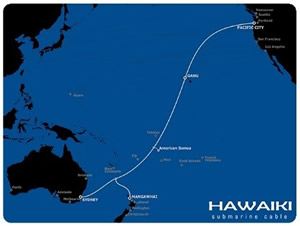
Consortium
for Ocean Leadership Becomes 5th Cable Owning Member of OFCC
On December 20th, 2010, the Consortium for Ocean Leadership
entered into an agreement with the Oregon Fishermen's Cable
Committee, Inc. (OFCC) becoming the fifth cable owning member
of the OFCC. The agreement covers the two undersea fiber optic
cables that will be laid off the Oregon coast near Pacific
City, OR. These undersea cables will be part of the Ocean
Observatories Initiative (OOI) Regional Scale Nodes (RSN).
One of those cables terminates near the Axial Seamount about
250 nm off Tillamook Head where sensors will monitor conditions
near the undersea volcano. The second cable will have segments
that approach the coast from the deep ocean abyss near Newport,
OR. The agreement addresses such issues as cable installation
and burial, inspection, participation in the OFCC Sacrificed
Gear Fund, a hot line number for fishermen to call to report
possible gear conflicts and the other topics found in the
usual OFCC cable agreements. As with other OFCC cables, fishermen
will be able to fish over the buried cable and be asked to
avoid towing over any exposed cable. These cables are unique
in that at four locations on one cable there are scientific
"nodes" that will have sensors and instruments attached. These
areas were selected in cooperation with representatives from
the fishing fleet in Newport in order to minimize the loss
of high value fishing grounds. The sensors and instruments
will be located in no fishing "safety zones" for their protection.
The OOI RSN will extend continuous high-bandwidth (tens of
Gigabits/second) and power (tens of kilowatts) to a network
of instruments widely distributed across, above and below
the seafloor in the northeast Pacific Ocean. As the world's
first ocean observatory to span a tectonic plate, this facility
will provide a constant stream of data in real time from the
ocean, on the seafloor, and below the seafloor within the
Juan de Fuca plate. This scientific data will be available,
via the internet, to the general public. The OOI is funded
by the National Science Foundation; for more information see
www.oceanobservatories.org.
The OOI has been developed to provide the U.S. ocean sciences
research community with access to the basic infrastructure
required to make sustained, long-term measurements in the
oceans.
The research cable will be installed in phases, with primary
cable backbone being installed in the summer of 2011, the
nodes being installed in the summer of 2012 and the secondary
cables, research instruments and sensors being installed in
2013 and 2014.
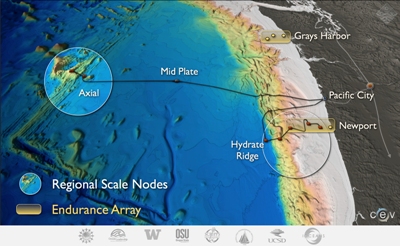
FISHERMEN!
UPDATE YOUR NAVIGATIONAL SOFTWARE TO INCLUDE THE NEW AKORN
CABLE POSITIONS.
Alaska Communications Systems Group, Inc. (ACS) has completed work on the Alaska Oregon Network (AKORN) cable project. This new submarine cable starts at Anchorage, Alaska and lands at Florence, Oregon. Installation of the AKORN cable went well with only one known cable exposure (~86 yds. long at ~727 fms. deep). The coordinates of this exposure are as follows:
43 45.838N 124 58.542W @ ~727 fms. (East End)
43 45.852N 124 58.598W @ ~727 fms. (West End)
As a result of this project and other recent cable inspections, Oregon Fishermen's Cable Committee has updated its navigational software programs. Included in the Version 6.5 update are the coordinates of the AKORN Cable and the one known cable exposure on AKORN described above. In addition, this version includes the coordinates of the other cables and all known exposures. Please ensure that you have this update loaded on your vessel's plotter. The OFCC currently has updates available for Nobeltec Visual Navigation Suite and ECC-GLOBE. Maptech Offshore Navigator and P-Sea WindPlot updates will be made available shortly.
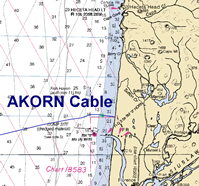
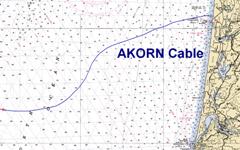
$170,000 MARINE DEBRIS CLEANUP
PROJECT TO COLLECT DERELICT FISHING GEAR FROM OREGON'S OCEAN
The Oregon Fishermen's Cable Committee (OFCC) recently initiated
a marine debris cleanup project aimed at removing lost crab
pots and trawl nets from Oregon's ocean waters. The project
is a partnership between the OFCC, the Oregon Dungeness Crab
and Salmon Commissions, the Oregon Dept. of Fish and Wildlife,
and the Oregon State Police, Oregon's commercial fishing and
crabbing industries, Tyco Telecommunications, and Oregon Sea
Grant. It is being supported by a $50,000 grant from the National
Oceanic and Atmospheric Administration, a significant corporate
donation from Tyco Telecommunications as well as donated services
from the other partners, for a total project budget of $170,000.
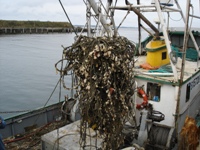
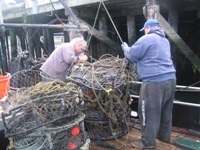
The derelict crab pot removal phase of the project was completed
in September and October 2006. The project successfully recovered
derelict crab pots from a site on the Northern Oregon Coast
and a site on Southern Oregon coast. This project resulted
in approximately 1200 acres being swept and cleaned of marine
debris.
The second phase of the project focused on grappling for and
removing sacrificed trawl gear from the seafloor. The fishing
gear was required to be abandoned to protect telecommunications
cables. After inspection of the sites determined that the
fishing gear was not hooked on the cable, the nets were slated
for removal. Over the course of three days at sea the F/V
Seeker successfully recovered three sets of complete gear
as well as one partial set of gear.
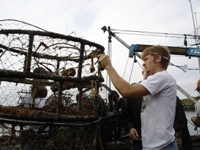
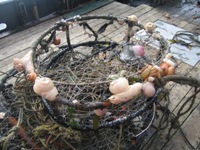
Both phases of this project not only improve the quality of
the ocean seafloor and its habitat but also return valuable
fishing grounds to productive use. Collection of this gear
minimizes potential gear hangs by reducing the number of seafloor
obstructions.
Benefits
of OFCC Membership
Current
OFCC Committee Members - June 2021
The committee is made up of representatives from the fishing
industry, cable company executives, and a telecommunication
specialist.
List
of Participating Vessels
Here is the list of trawl vessels that have signed up for
membership in the OFCC.
GCI and
OFCC Sign Agreement
General Communication Inc. (GCI) signed an agreement with
the Oregon Fishermen’s Cable Committee on January 17,
2003. The agreement covers a proposed new cable to be known
as Alaska United West. The cable will land on Clatsop beach
near the town of Warrenton, OR. and in Seward, AK. The cable
will be buried through the fishing grounds off Oregon. The
agreement is almost identical to the one signed by Tyco Telecommunications
for the Tyco Global Network Pacific cable system which has
three Oregon landings in Tillamook County, OR. GCI is the
largest telecommunications provider in Alaska. The company
provides local, wireless, and long distance telephone service,
cable television, Internet and data communication. More information
about the company can be found at www.gci.com.
Tyco
Completes New Cable System
With the successful installation of Tyco Global Network (TGN)
Pacific Ring Segment 6 cable off the Oregon coast in August
of 2002, the TGN network is now complete. The cable system
has three landings in Oregon. Two of the cables carry telecommunications
traffic to Japan; one connects to the Los Angeles area of
California. The cables are among the highest capacity cables
in the world with the ability, when fully equipped, to convey
over 5 terabits of data per second on each cable. Tyco installed
their own cable and achieved 100% burial in the fishing grounds
on Seg. 6. Fisherman Jim Seavers, who was aboard the installation
vessel, had high praise for the installation: “Tyco
went out of their way to make sure the survey was done well
enough to insure we would have a route that would insure good
burial, and that is what they accomplished”.
The Tyco cable system was purchased by Tata Communications and is now known as Tata Global Network (TGN).
|
